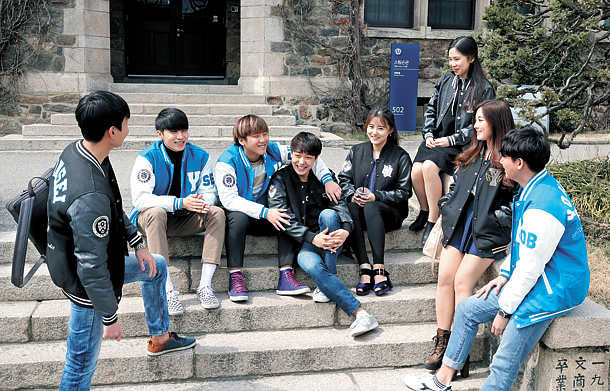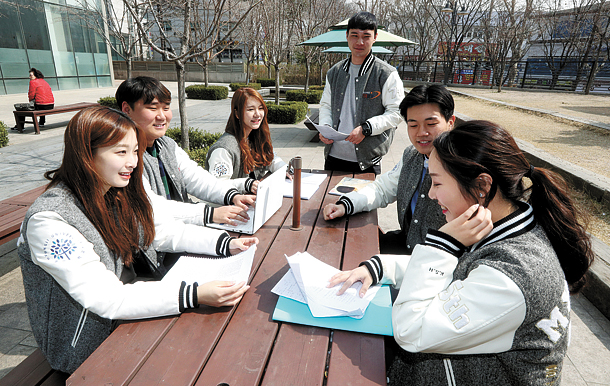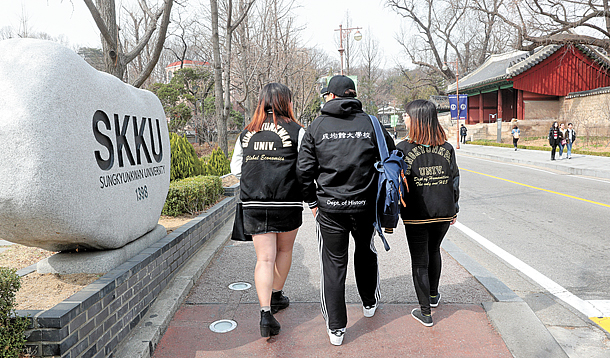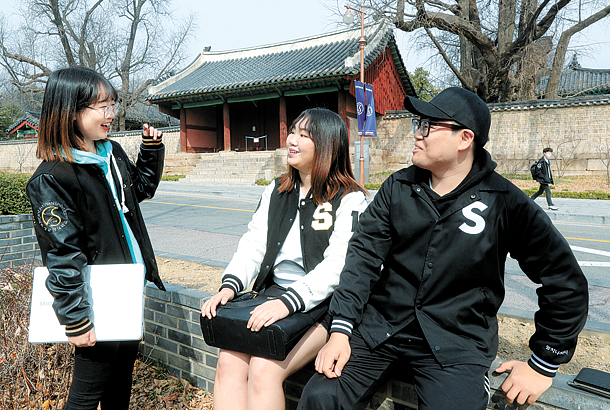Wearing their school pride on their sleeves: Students decked out in varsity jackets are a sign that spring is here

Yonsei University students sporting the gwajams sit in front of Stimson Hall at Yonsei University’s Sinchon Campus. On the back of the gwajams is the university’s name, and on the sleeves are the university’s symbol or emblem. [KANG JEONG-HYUN]
The gwajam - a portmanteau of university department, or gwa, and jacket, or jamba - is a varsity jacket that students of the same department wear to identify themselves. Students rush to pick up these jackets, noting their practicality and reasonable price of 40,000 won ($35).
Students show off their belonging to a certain community on campus by wearing their gwajam. University freshmen who spent their high school days studying hard to get into university strut through the streets wearing their jackets with pride.
Young university students wearing gwajam in college neighborhoods have now become a harbinger of spring - as reliable as blooming flowers and the yellow dust.
There were streams of students bearing Sungkyunkwan University and their departments across their backs at the gates of the university in Daehangno, central Seoul, on March 23. The embroidered letters detailing individual departments sit in smaller letters below the university’s name emblazoned across the shoulders.
On the chest of the jackets was the university’s initials and the sleeves bore the university’s symbols and the student’s year of admission.

For freshman Hwang Ji-won, the gwajam felt especially meaningful. “I just had to be accepted to Sungkyunkwan University,” said Hwang. “The belongingness and accomplishment I feel when I am wearing my gwajam will stay with me for the remainder of my university years.”
At Yonsei University’s Sinchon campus, students wearing the gwajam can be seen everywhere in the crowds of people walking on Baekyang Road (Underwood Road). There were even students wearing matching black baseball jackets in the mix.
“This is not a gwajam, but a jacket that us close friends chose to get together,” said Sung Gyeong-jun, a history major at Yonsei University. “Because it was a small order, the [price of the jackets were] 60,000 won each, but we’re satisfied.” At Myongji University, the members of the PR Press club wore matching jackets in solidarity while holding a meeting.
“After buying and wearing the gwajam bearing the name of the university and the department as a cohort, students feel a sense of belonging,” said Yoon In-jin, a sociology professor at Korea University. “I also think that there is a desire to show off.”

Members of MJU Pride, Myongji University’s PR Press club, sit around a table discussing future reporting plans. [KANG JEONG-HYUN]
The gwajam is generally a varsity letterman jacket. However, the traditional look is shifting to include a whole spectrum of colors. For example, there are many gwajam featuring colors such as purple and green on the market; some companies even offer pastel options.
Nowadays, the start of the semester is the busy season for clothing manufacturers as the demand rises for gwajam and university apparel. UDanchaebok, a clothing manufacturer located in Gangnam, southeastern Seoul, makes 50 percent of their yearly sales in the months of February, March and April. In order to handle the amount of orders, they have had to hire extra employees.
Another manufacturer in Dongdaemun, eastern Seoul, is looking for a new factory to meet their increasing rise in orders.
However, students unable to graduate within four years due to difficulty in finding employment have taken to distancing themselves from bearing the scarlet number of their hakbeon, or year of admission. Higher admission years are called “fossil hakbeon” between students. Consequently, designs without the year of admission emblazoned on the sleeve are now being offered, reflecting the awareness of the social stigma.

Students at Sungkyunkwan University sporting gwajams of their respective departments pass by the famous boulder engraved with the university’s initials and date of inception. [KANG JEONG-HYUN]
The origin of and exactly when gwajam became a trend at Korean universities is something of a mystery. It is thought that the gwajam first came from the baseball jumpers that physical education department students often sported during the late 1990s.
Baseball letterman jackets first appeared in the United States with the Harvard University baseball team. It started as a knit sweater, but from 1930 onwards, it became a jacket. At the time, a large crimson H was embroidered on the jackets.

Sungkyunkwan University students wearing their gwajams take a break from studying in the university’s Humanities and Social Sciences Campus. [KANG JEONG-HYUN]
There is a perspective that with the spread of the gwajam phenomenon to the provinces outside of the Seoul metropolitan area, academic discrimination is being eliminated across the country. However, others insist that the jackets are exacerbating academic discrimination that has existed for decades.
There are many prestigious universities on Seoul Metro’s line No. 2. Riding the subway, one can easily spot students wearing gwajam from Seoul National University, Yonsei University and Ewha Womans University.
“[Wearing gwajam], is admittedly a way of boasting.” said one sophomore at Ewha Woman’s University.
On social media, the jackets have become a hot topic of discussion, which some saying, “You need guts to ride the subway with your gwajam on unless it’s from the top 5 universities in Korea.”
One senior attending a university in Gyeonggi said, “I’m commuting from Yeongdeungpo, [southwestern] Seoul, [but] I feel a bit embarrassed wearing my gwajam.”
Kim Sung-yun, head of the Center for Culture & Society said, “It is uncertain [as of yet] whether there are instances of academic discrimination from wearing gwajam. Contrary, it is probably more correct to say that because of academic discrimination, the gwajam have become problematic.”
Lim Myung-ho, professor of psychology at Dankook University also warned, “We must be vigilant of belittling and discriminating against other groups within collective consciousness. Mutual respect should be shown.”
BY KIM MIN-WOOK [kim.jungkyoon@joongang.co.kr]
지금 대학 캠퍼스는 ‘과잠’의 계절이다. 봄꽃 이야기가 아니다. 여기저기 울긋불긋 각양각색 과잠들의 향연이 벌어지고 있다. 과잠은 같은 학과 학생들끼리 단체로 맞춰 입은 잠바를 일컫는다. 학과 단체 티셔츠를 ‘과티’로 압축해 부르는 것처럼 학과 잠바의 약칭은 과잠이다. 학과가 나눠지기 전의 학부생 잠바는 ‘학잠’이고 동아리 잠바는 ‘동잠’이다. 4만원대의 합리적인 가격에다 활용도가 뛰어나다고 학생들은 입을 모은다.
과잠은 대학에서 기념품으로 판매하거나 일괄 구매해 신입생들에게 나눠주는 학교 잠바, 즉 학잠보다는 세분화됐다. 과잠을 통해 강한 소속감과 일체감이 부여된다고 학생들은 강조한다. 과잠은 주로 봄·가을용 겉옷이다 보니 요즘 같은 초봄에 대학가에서 가장 흔하게 볼 수 있다. 특정 대학 학과의 과잠이 고교 시절 꼭 입어보고 싶었던 선망의 대상이었던 대학 1학년 새내기들의 경우 과잠을 자주 입고 다닌다고 한다.
3월 대학가에서 감수성 넘치는 학생들은 과잠을 일컬어 ‘봄꽃보다 먼저 핀 꽃’으로 비유한다. 하지만 다른 한쪽에서는 과잠이 위화감을 자극한다는 지적도 나온다. 전문가들은 “개별 학과·대학에 대한 가치존중의 태도를 갖는 게 필요하다”고 조언한다.
지난 23일 오전 서울 대학로 인근 성균관대 인문사회과학캠퍼스. 정문에서 600주년 기념관 방향으로 오르는 길에서 대학·학과명 등의 정보가 담긴 옷을 입은 학생들이 여러명 눈에 띄었다. 이게 바로 과잠이다. 성균관대학교라는 대학명은 영어 ‘SUNGKYUNKWAN UNIV.’ 또는 한자 ‘成均館大學校’로 표기됐다. 글자가 제법 커 성대생임을 한눈에 알아볼 정도다. 학과명은 대학명 밑에 상대적으로 작은 글씨로 박음질돼 있지만 주로 검은색 옷 위에 노란색 또는 흰색 실을 사용해 눈에 잘 띄었다. 왼쪽 가슴에는 대학의 영문 이니셜이, 소매에는 대학 상징물 또는 학번이 새겨진다.
성대 사학과에 재학 중인 윤호성(20)씨는 과잠을 즐겨 입는 이유로 활동성을 꼽았다. 시험 기간이 되면 대부분의 재학생이 과잠 차림이라는 게 그의 설명이다.
성대 새내기 황지원(19·여)씨에게 과잠은 고교 시절 선망의 대상이었을 정도로 특별하다. 그는 “성대는 꼭 진학하고 싶은 대학이었다”며 “앞으로의 대학생활에서 과잠이 줄 소속감과 성취감이 남다를 것 같다”고 말했다.
이날 오후 찾아간 연세대 신촌캠퍼스. 백양로(언더우드길)를 오가는 인파 사이에서 과잠을 입은 학생들이 곳곳에 눈에 띄었다. 동기끼리 맞춘 검은색 야구점퍼를 걸친 학생도 있었다. 연세대 사학과에 재학 중인 성경준(21)씨는 “과잠이 아닌 친한 친구 4명이 맞춘 것”이라며 “소량 구매라 단가가 6만원대로 올랐지만 만족한다”고 말했다. 명지대에서는 홍보기자단 동아리 회원들이 잠바를 맞춰 입고 모여 회의를 가졌다. 결속력을 높이기 위해서다.
윤인진 고려대 사회학과 교수는 “과잠은 학교와 학과를 드러내는 이름표를 달고 단체로 구매해 입다 보니 소속감을 갖게 된다”며 “과시욕구도 있을 것으로 생각한다”고 말했다.
요즘 새학기를 맞아 과잠을 비롯해 학잠·동잠 등의 제작 수요가 늘어나면서 관련 의류업계는 대목이다. 서울 강남의 U단체복 제작업체는 2~4월 3개월간의 매출이 연간 매출의 50%를 차지한다. 업체는 밀려오는 주문 물량을 처리하기 위해 직원 수도 늘렸다고 한다.
서울 동대문의 한 단체복 제작 업체는 적기 납품 등을 위해 새로운 공장을 알아보는 중이다. 직영공장으로 일손이 모자라 외주제작에 손을 벌리고 있다. 새학기마다 벌어지는 일명 ‘과잠 특수’다.
과잠 디자인은 보통 야구점퍼가 대세다. 몸통과 소매가 다른 색으로 이뤄진다. 예컨대 자주색과 초록색처럼 보색대비 효과를 주거나 무채색 계열로 명도를 높인 디자인이 많다.
소매는 인조가죽이다. U단체복 업체 관계자는 “천연가죽으로 할 경우 과잠 판매가(4만원대)가 3배 이상 비싸진다”고 말했다. 요새는 야구점퍼 대신 허리부분 밴드와 인조가죽 소매 등이 없는 코치스타일이나 항공점퍼 스타일의 과잠도 인기다.
대학가에서 취직이 잘 안 돼 졸업을 유예하는 바람에 입학한 지 4년이 훌쩍 넘은 고학번을 ‘화석학번’이라 부른다. 이런 사회상을 반영하듯 최근 과잠 소매에 학번을 표시하지 않는 디자인도 등장하고 있다.
과잠이 언제부터 국내 대학에서 유행했는지 유래는 정확하지 않다. 다만 대학가에서는 1990년대 후반 사회체육학과를 중심으로 학생들이 편하게 즐겨 입던 야구점퍼 형태의 과잠이 점차 일반 학과로도 퍼진 것으로 전해지고 있다.
해외에서는 야구점퍼가 1865년 미국 하버드대 야구팀에서 처음 등장했다는 것이 패션업계의 정설이다. 니트에서 1930년 이후 점퍼 형태로 바뀌었다. 당시 하버드대 이니셜인 ‘H’를 새겼는데 현재 과잠 왼쪽 가슴에 대학 이니셜을 박음질하는 것과 유사하다.
과잠이 지방으로까지 확산하면서 학력 차별의 해소 시도로 평가하는 시각도 있다. 반대로 학벌 차별을 조장한다는 비판도 받고 있다.
서울 지하철 2호선 노선상에는 유명 대학이 대거 몰려 있다. 지하철 2호선을 타고 등하교하는 서울대·연세대·이대생들이 과잠을 입고 다니는 모습이 자주 목격된다. 이화여대 2학년 학생은 “(과잠을 입는 데는) 과시욕구도 없잖아 있다”고 말했다.
이 때문에 소셜네트워크서비스(SNS)에는 “웬만한 대학의 과잠을 입고서는 서울에서 지하철 탈 용기가 안 난다”는 말도 나온다. 실제로 익명을 요구한 경기도 내 4년제 대학 재학생(21)은 “서울 영등포에서 통학하는데 과잠을 입기가 좀 창피하다”고 토로했다.
김성윤 문화사회연구소장은 “과잠 입기가 학벌 차별을 부추기는 행위인지는 불분명하다”며 “거꾸로 학벌 차별 때문에 과잠이 문제적 현상이 된 것이라 보는 게 맞다”고 말했다.
임명호 단국대 심리학과 교수는 “집단의식 속에서 상대집단을 비하하고 차별하는 것은 경계해야 한다. 가치존중의 태도를 가져야 한다”고 말했다.
[S BOX] 조선시대 성균관 유생들 ‘청금복’이 첫 교복
한민족 역사상 법으로 정한 최초의 교복은 조선시대 성균관 유생들이 입었던 청금복(靑衿服·사진)이다. 과거 고구려·백제·신라 삼국시대 때 인재 교육기관에서 제복을 입히기는 했지만 법으로 따로 정하지는 않았다.
태종 11년 처음으로 청금복이 성균관 유생들의 복장으로 제정된 후 성종 8년 당시 기본법전인 경국대전(經國大典)에서 성균관 유생의 의복을 청금복으로 규정했다.
청금복의 유래는 중국 고서인 시경(詩經)에 전해진다. ‘청청자금 유유아심(靑靑子衿 悠悠我心·푸르고 푸른 임의 옷깃, 기나긴 것은 이내 마음이로다)에서 차용했다. 유생들의 청금복은 맑고 푸른색을 띠고 있었던 것으로 전해진다. 청금복은 다양한 의미를 품고 있는데 우선 의례성을 든다. 예를 중시함으로써 모든 종류의 의식과 삶의 행동 등을 바르게 세울 수 있기 때문이다.
성균관 유생들의 학생복은 과거 국상 등 특별한 날을 제외하곤 청금에 유건으로 변함 없었다.
둘째는 청빈성이다. 유생들은 검약과 절제를 미덕으로, 청렴과 청빈을 우선 가치로 삼았다고 한다. 마지막으로 청금복은 지위 상징성을 갖는다. 민신홍 전 성균관대 유생문화기획단장은 “청금을 입는다는 것은 즉 유생이라는 지위에 걸맞은, 바람직한 언행을 해야 한다는 무언의 표식”이라고 설명했다.
글=김민욱










with the Korea JoongAng Daily
To write comments, please log in to one of the accounts.
Standards Board Policy (0/250자)